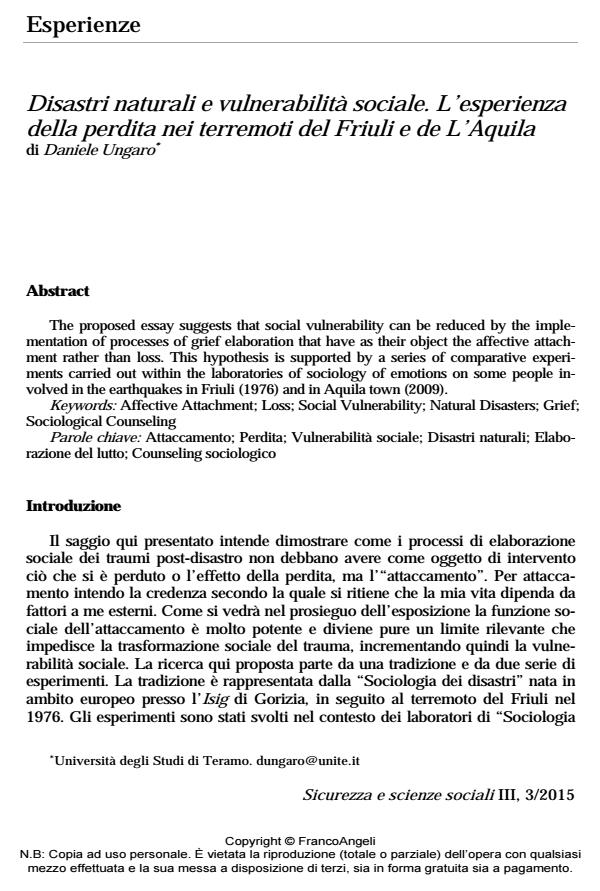Disastri naturali e vulnerabilità sociale. L’esperienza della perdita nei terremoti del Friuli e de L’Aquila
Journal title SICUREZZA E SCIENZE SOCIALI
Author/s Daniele Ungaro
Publishing Year 2016 Issue 2015/3 Language Italian
Pages 10 P. 75-84 File size 66 KB
DOI 10.3280/SISS2015-003007
DOI is like a bar code for intellectual property: to have more infomation
click here
Below, you can see the article first page
If you want to buy this article in PDF format, you can do it, following the instructions to buy download credits

FrancoAngeli is member of Publishers International Linking Association, Inc (PILA), a not-for-profit association which run the CrossRef service enabling links to and from online scholarly content.
The proposed essay suggests that social vulnerability can be reduced by the implementation of processes of grief elaboration that have as their object the affective attachment rather than loss. This hypothesis is supported by a series of comparative experiments carried out within the laboratories of sociology of emotions on some people involved in the earthquakes in Friuli (1976) and in Aquila town (2009).
Keywords: Affective Attachment; Loss; Social Vulnerability; Natural Disasters; Grief; Sociological Counseling
- Weber M. (1922). Wirtschaft und Gesellschaft. Tübingen: Mohr (trad. it.: Economia e società. Milano: Edizioni di Comunità, 1968).
- Ungaro D. (2013). Ho visto camminare le aquile. Abruzzo: la prova del terremoto. In: Farinosi M., Micalizzi A., a cura di, Net-Quake. Media digitali e disastri naturali, Milano: FrancoAngeli.
- Stein E. (1917). Zum Problem der Einfühlung. Halle: Buchdruckerie des Weisenhauses (trad. it.: Il problema dell’empatia. Roma: Studium, 2012).
- Schutz A. (1932). Der sinnhafte Aufbau der sozialen Welt. Wien: Springer (trad. it.: La fenomenologia del mondo sociale. Bologna: il Mulino, 1974).
- Rovatti P.A. (2007). Abitare la distanza. Milano: Cortina.
- Polster E. (1973). Gestalt Therapy Integrated. New York: Vintage Book (trad. it.: Terapia della Gestalt integrate. Milano: Giuffré, 1986).
- Freud S. (1917). Trauer und Melanchonie. Internationale Zeitschrift für Ärztliche Psychoanalyse, 4, VI: 288-301 (trad. it. Lutto e malinconia. Torino: Boringhieri, 1978).
- Dynes R.R., Pelanda C., De Marchi B., a cura di (1987). Sociology of Disasters. Contribution of Sociology to Disaster Research. Milano: FrancoAngeli.
- Di Sopra L., Pelanda C., a cura di (1984). Teoria della vulnerabilità. Milano: Franco Angeli.
- Cattarinussi B., Pelanda C., a cura di (1981). Disastro e azione umana. Introduzione multidisciplinare allo studio del comportamento sociale in ambienti estremi. Milano: FrancoAngeli.
- Cattarinussi B., Strassoldo R., a cura di (1978). Friuli: la prova del terremoto. Milano: FrancoAngeli.
- Baiocchi P. (2004). L’elaborazione del lutto. La gestione della perdita e dell’attaccamento affettivo. Istituto Gestalt Trieste, testo disponibile al sito: www.istitutogestalttrieste.net.
- Ardigò A. (1988). Per una sociologia oltre il postmoderno. Roma-Bari: Laterza.
- Alberoni F. (1977). Movimento e istituzione. Bologna: il Mulino.
Daniele Ungaro, Disastri naturali e vulnerabilità sociale. L’esperienza della perdita nei terremoti del Friuli e de L’Aquila in "SICUREZZA E SCIENZE SOCIALI" 3/2015, pp 75-84, DOI: 10.3280/SISS2015-003007